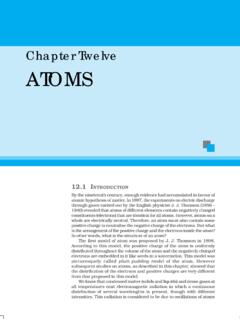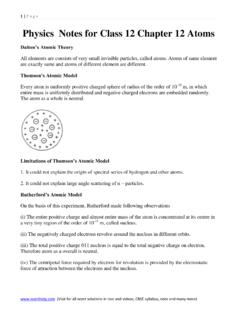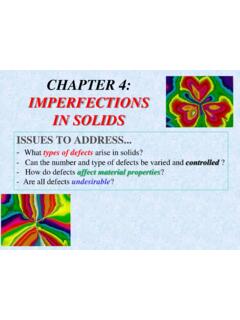Transcription of Grade 9 Science Unit 1: Atoms, Elements, and Compounds
1 Grade 9 Science UNIT 1: ATOMS, elements , AND Compounds c h a p t e r 1 UNIT TERMS Use term handout to define all terms for this unit. SAFETY IN THE Science CLASSROOM Read pages 8-9 Activity 1-1A Page 9 ** Look for 14 things! Page 10-11 WHIMIS SYMBOLS Page 12 ExploreMore - Page 13 INVESTIGATING MATTER WHAT IS MATTER? Matter is anything that has mass and volume. Mass is the amount of matter in a substance or object. Volume is the amount of space a substance or object occupies. Matter is made up of elements elements are substances that contain one type of matter and cannot be broken down or separated into simpler substances In chemistry, the Periodic Table of elements is used to organize elements PERIODIC TABLE OF elements DESCRIBING MATTER Properties (p.)
2 18) Characteristics of matter that are often observed or measured Can be either qualitative (observed) or quantitative (measured). EXAMPLES OF PHYSICAL PROPERTIES Color Malleability Luster Conductivity Boiling Point Melting Point Texture Magnetism Density VIDEO DESCRIBING MATTER CONTINUED PG. 19 Properties Observed when substances react with each other Determines a substances usefulness Examples Reactivity Combustibility Toxicity CORE LAB Physical & Chemical Properties Page 20 SECTION ~ ATOMIC THEORY THEORY VS. LAW A theory is less well supported than a law. Most laws are supported by different and robust experimental evidence. ATOMIC THEORY The descriptions of matter and how it behaves.
3 Has undergone many modifications as new facts became available. EARLY YEARS AGO Empedocles: matter was composed of four elements : Earth Air Wind Fire Aristotle agreed with Empedocles and no one seriously challenged it for the next 2000 years. Democritus: eventually a substance will be cut into a piece that can no longer be cut. He called this piece atomos. THE DEVELOPMENT OF THE ATOMIC THEORY John Dalton (1766-1844) British schoolteacher and scholar He is credited with developing a theory that was a new way of describing matter He suggested that the particles that make up matter are like small, hard spheres that are different from different elements He defined an atom as the smallest particle of an element DALTON S ATOMIC THEORY All matter is made up of small particles called atoms Atoms cannot be created, destroyed, or divided into smaller particles.
4 All atoms of the same element are identical in mass and size, but they are different in mass and size from the atoms of other elements Compounds are created when atoms of different elements link together in definite proportions. DALTON S BALL MODEL THOMSON British physicist He studied electric currents in gas discharge tubes, which are related to today s fluorescent lights. He suggested that all atoms must contain electrons (negative charge) His model pictured a positively charged ball with the negatively charged electrons embedded in it. THOMSON S BUN MODEL Pictured positively charged ball like a bun with negatively charged particles embedded in it like raisins ERNST RUTHERFORD (1871-1937) He was a scientist from New Zealand (worked at McGill University, Montreal) He discovered that atoms have a nucleus Nucleus: the tiny, dense, positively charged centre of the atom There are two kinds of particles in the nucleus; protons (positive charge) and neutrons (neutral) RUTHERFORD S PLANETARY MODEL NIELS BOHR (1885-1962) He proposed that electrons surround the nucleus in specific energy levels or shells.
5 Each electron has a particular amount of energy. BOHR S MODEL Rutherford was able to develop Thomson s model due to the development of new technologies (gold foil experiment) The development of cyclotrons and proton accelerators have further developed the model accepted today. SUMMARY DEVELOPMENT OF ATOMIC THEORY WORKSHEET ATOMIC THEORY DEVELOPMENT RECAP - CUE CARDS + MARKER Who described matter as being made up of four elements ; earth, air, wind and fire? a)Aristotle b)Democritus c)Empedocles d)JJ Thompson Who agreed with Empedocles theory about the four elements : a)Aristotle b)Democritus c)Empedocles d)JJ Thompson Who described a substance that could no longer be cut as an atomos?
6 A)Aristotle b)Democritus c)Empedocles d)JJ Thompson Who defined the atom as the smallest particle of an element? a)Aristotle b)Democritus c)JJ Thompson d) John Dalton Who said that all matter is made up of particles called atoms? a)Aristotle b)Democritus c)JJ Thompson d) John Dalton Who stated that atoms cannot be created, destroyed or divided into smaller particles? a)Aristotle b)Democritus c)JJ Thompson d) John Dalton What are electrons? a)Neutrally charged particles b)Negatively charged particles c)Particles with no charge d)Positively charged particles What are protons? a)Neutrally charged particles b)Negatively charged particles c)Particles with no charge d)Positively charged particles What are neutrons?
7 A)Neutrally charged particles b)Negatively charged particles c)Particles with no charge d)Positively charged particles Who suggested that all atoms must contain electrons? a)Aristotle b)Democritus c)Empedocles d)JJ Thompson Whose theory does this diagram represent? a)Aristotle b)Democritus c)Empedocles d)JJ Thompson Who discovered that atoms had a nucleus? a)Aristotle b)Democritus c)Ernest Rutherford d)JJ Thompson Which best describes the nucleus of an atom? a)Tiny, dense and positively charged b)Tiny, dense and negatively charged c)Large, dense and positively charged d)Large, dense and negatively charged What are the two types of particles in the nucleus? a)Neutrons and protons b)Neutrons and electrons c)Protons and electrons d)None Who proposed that electrons have a particular amount of energy and surround the nucleus?
8 A)Aristotle b)Democritus c)Ernest Rutherford d)Neil Bohr INSIDE THE ATOM An atom is the smallest particle of an element that retains the properties of the element. All atoms are made up of three kinds of smaller particles call subatomic particles. Three Subatomic Particles: Protons (positively charged) Electrons (negatively charged) Neutrons (no charge) Subatomic Particle Charge Mass Location Proton (p+) + Large Nucleus Neutron (n) 0 Large Nucleus Electron (e-) - Very small Energy Levels THE ATOM MASS Protons and neutrons have much more mass than electrons This means that when you lift up a large rock, it is the protons and neutrons in the rock that weigh it down Protons and neutrons have about the same they have about 1800 times more mass than an electron ELECTRIC CHARGE The electric charge comes in two types.
9 Positive Negative Because negative and positive charges attract each other, protons (positive) and electrons (negative) are attracted together Each proton counts as +1, and each electron counts -1. All atoms have an equal number of protons and electrons This means that the charges add up to zero, making the atom uncharged or neutral. BILL NYE: ATOMS READ PAGES 28 - 29 Test your knowledge: QUESTIONS PAGE 33 #15, 17








